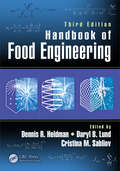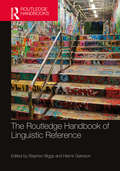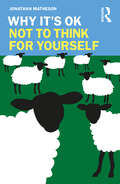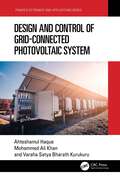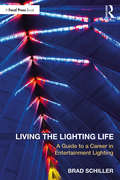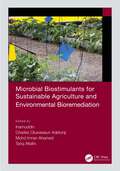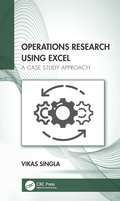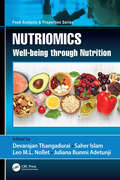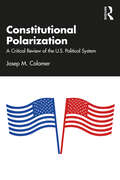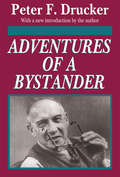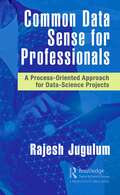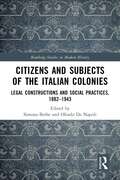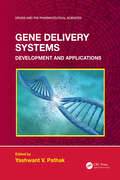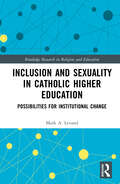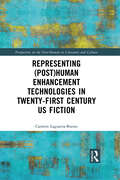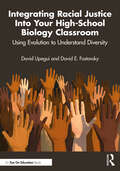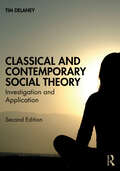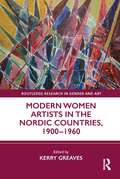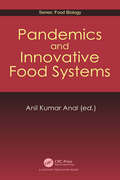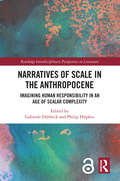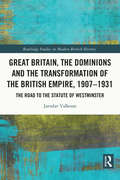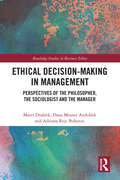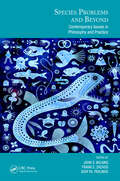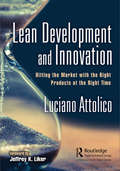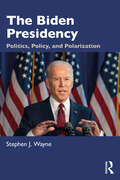- Table View
- List View
Handbook of Food Engineering
by Edited by Dennis R. Heldman Daryl B. Lund Cristina M. SabliovAs the complexity of the food supply system increases, the focus on processes used to convert raw food materials and ingredients into consumer food products becomes more important. The Handbook of Food Engineering, Third Edition, continues to provide students and food engineering professionals with the latest information needed to improve the efficiency of the food supply system.As with the previous editions, this book contains the latest information on the thermophysical properties of foods and kinetic constants needed to estimate changes in key components of foods during manufacturing and distribution. Illustrations are used to demonstrate the applications of the information to process design. Researchers should be able to use the information to pursue new directions in process development and design, and to identify future directions for research on the physical properties of foods and kinetics of changes in the food throughout the supply system.Features Covers basic concepts of transport and storage of liquids and solids, heating and cooling of foods, and food ingredients New chapter covers nanoscale science in food systems Includes chapters on mass transfer in foods and membrane processes for liquid concentration and other applications Discusses specific unit operations on freezing, concentration, dehydration, thermal processing, and extrusion The first four chapters of the Third Edition focus primarily on the properties of foods and food ingredients with a new chapter on nanoscale applications in foods. Each of the eleven chapters that follow has a focus on one of the more traditional unit operations used throughout the food supply system. Major revisions and/or updates have been incorporated into chapters on heating and cooling processes, membrane processes, extrusion processes, and cleaning operations.
The Routledge Handbook of Linguistic Reference (Routledge Handbooks in Philosophy)
by Stephen BiggsThis Handbook offers students and more advanced readers a valuable resource for understanding linguistic reference; the relation between an expression (word, phrase, sentence) and what that expression is about. The volume’s forty-one original chapters, written by many of today’s leading philosophers of language, are organized into ten parts:I Early Descriptive TheoriesII Causal Theories of ReferenceIII Causal Theories and Cognitive SignificanceIV Alternate TheoriesV Two-Dimensional SemanticsVI Natural Kind Terms and RigidityVII The Empty CaseVIII Singular (De Re) ThoughtsIX IndexicalsX Epistemology of Reference Contributions consider what kinds of expressions actually refer (names, general terms, indexicals, empty terms, sentences), what referring expressions refer to, what makes an expression refer to whatever it does, connections between meaning and reference, and how we know facts about reference. Many contributions also develop connections between linguistic reference and issues in metaphysics, epistemology, philosophy of mind, and philosophy of science.
Why It's OK Not to Think for Yourself (Why It's OK)
by Jonathan MathesonWe tend to applaud those who think for themselves: the ever-curious student, for example, or the grownup who does their own research. Even as we’re applauding, however, we ourselves often don’t think for ourselves. This book argues that’s completely OK.In fact, it’s often best just to take other folks’ word for it, allowing them to do the hard work of gathering and evaluating the relevant evidence. In making this argument, philosopher Jonathan Matheson shows how 'expert testimony' and 'the wisdom of crowds' are tested and provides convincing ideas that make it rational to believe something simply because other people believe it. Matheson then takes on philosophy’s best arguments against his thesis, including the idea that non-self-thinkers are free-riding on the work of others, Socrates’ claim that 'the unexamined life isn’t worth living,' and that outsourcing your intellectual labor makes you vulnerable to errors and manipulation. Matheson shows how these claims and others ultimately fail -- and that when it comes to thinking, we often need not be sheepish about being sheep.Key Features Discusses the idea of not thinking for yourself in the context of contemporary issues like climate change and vaccinations Engages in numerous contemporary debates in social epistemology Examines what can be valuable about thinking for yourself and argues that these are insufficient to require you to do so Outlines the key, practical takeaways from the argument in an epilogue
Design and Control of Grid-Connected Photovoltaic System (ISSN)
by Ahteshamul Haque Mohammed Ali Khan V S KurukuruThe current model for electricity generation and distribution is dominated by centralized power plants which are typically associated with combustion (coal, oil, and natural gas) or nuclear generation units. These power models require distribution from the center to outlying consumers and have many disadvantages concerning the electric utilities, transmission and distribution, and greenhouse gas emissions. This resulted in the modelling and development of cleaner renewable power generation with alternative sources such as photovoltaic (PV), wind, and other sources. Further, due to matured PV technology, constant drop-in installation cost, greenhouse emissions reductions, energy efficiency, reduced transmission and distribution investments, minimization of electric losses, and network support, the development of PV systems is proliferating. In view of this development, this book provides an idea for setting up the PV plant from initial study of the site to plan sizing. Once the first planning is covered, the book focuses on the modeling aspects of power electronics converter and control elements associated with it keeping the operating standards specified for the development of distributed generation systems in check.This book will be useful for industrial professionals and researchers who are working toward modeling of PV plants, and their control in grid connected operation. All the necessary information related to these fields is available in the book.
Living the Lighting Life: A Guide to a Career in Entertainment Lighting
by Brad SchillerLiving the Lighting Life provides practical tools and advice for a successful career in entertainment lighting. This easy-to-navigate guide offers real-world examples and documentation from the author and key industry experts, giving readers a comprehensive overview of the lighting life. The book provides insight on: Different job opportunities in the entertainment lighting industry; Business procedures, contracts, time sheets, and invoices; Tips on self-promotion, networking, and continual learning; The lighting lifestyle, healthy living, and work-related travel; Maintaining and developing creativity to provide innovative lighting and solutions. With insightful interviews from industry veterans, Living the Lighting Life is a key navigational resource for anyone considering a career in entertainment lighting or just starting out.
Microbial Biostimulants for Sustainable Agriculture and Environmental Bioremediation
by InamuddinToday, the agriculture industry is confronted with simultaneous issues of how to fully embrace mass production of safer food in terms of both quality and quantity. Most industries are concerned with avoiding significant levels of soil pollution and environmental threats as a result of the excessive and harmful use of synthetic products on crops. Therefore, there is a need to adopt sustainable technological innovations that can ensure the sustainability of agricultural production systems.Microbial Biostimulants for Sustainable Agriculture and Environmental Bioremediation discusses the benefits, challenges, and practical applications of eco-friendly biotechnological techniques using biostimulants derived from beneficial microorganisms. The chapters cover the use of these organisms to increase crop production, enhance soil fertility and maintain soil health, create crop and plant tolerance to different abiotic stressors, release required nutrients to the soil, increase resistance to plant pathogens/pests, improve nutrient use efficiency of crops, and rejuvenate polluted environments.FEATURES Explores the physiological, morpho-anatomical, and biochemical molecular plant rejoinders involved in stimulating crop productivity Provides information on the physiological, cellular, and molecular modes of action underlying microbial biostimulant interfaces Summarizes methods and approaches for executing microbial stimulant technology Outlines numerous environmental management and remediation strategies This book is an ideal resource for researchers, engineers, and academics working in soil science, crop science, water remediation, microbiology, and biotechnology.
Operations Research Using Excel: A Case Study Approach
by Vikas SinglaThe field of operations research provides a scientific approach to managerial decision making. In a contemporary, hypercompetitive ever-changing business world, a manager needs quantitative and factual ways of solving problems related to optimal allocation of resources, profit/loss, maximization/minimization etc. In this endeavor, the subject of doing research on how to manage and make operations efficient is termed as Operations Research. The reference text provides conceptual and analytical knowledge for various operations research techniques. Readers, especially students of this subject, are skeptic in dealing with the subject because of its emphasis on mathematics. However, this book has tried to remove such doubts by focusing on the application part of OR techniques with minimal usage of mathematics. The attempt was to make students comfortable with some complicated topics of the subject. It covers important concepts including sensitivity analysis, duality theory, transportation solution method, Hungarian algorithm, program evaluation and review technique and periodic review system. Aimed at senior undergraduate and graduate students in the fields of mechanical engineering, civil engineering, industrial engineering and production engineering, this book:• Discusses extensive use of Microsoft Excel spreadsheets and formulas in solving operations research problems• Provides case studies and unsolved exercises at the end of each chapter• Covers industrial applications of various operations research techniques in a comprehensive manner• Discusses creating spreadsheets and using different Excel formulas in an easy-to-understand manner• Covers problem-solving procedures for techniques including linear programming, transportation model and game theory
Nutriomics: Well-being through Nutrition (ISSN)
by Devarajan Thangadurai Saher Islam Leo M.L. Nollet Juliana Bunmi AdetunjiImplementation of robust omics technologies enables integrative and holistic interrogation related to nutrition by labeling biomarkers to empirically assess the dietary intake. Nutriomics: Well-being through Nutrition aims to enhance scientific evidence based on omics technologies and effectiveness of nutrition guidelines to promote well-being. It provides deep understanding towards nutrients and genotype effects on disease and health status. It also unveils the nutrient–health relation at the population and individual scale. This book helps to design the precise nutritional recommendations for prevention or treatment of nutrition-related syndromes.Nutriomics: Well-being through Nutrition focuses on: The impact of molecular approaches to revolutionize nutrition research for human well-being Various biomarkers for bioactive ingredient analysis in nutritional intervention research Potential of transcriptomic, genomic, proteomic, metabolomic, and epigenomic tools for nutrition care practices Recent updates on applications of omics technologies towards personalized nutrition Providing comprehensive reviews about omics technologies in nutritional science, Nutriomics: Well-being through Nutrition serves as an advanced source of reference for food developers, nutritionists, and dietary researchers to investigate and evaluate nutriomics tools for development of customized nutrition and food safety. It is also a useful source for clinicians and food industry officials who require intense knowledge about emerging dietary-related tools to revolutionize the nutrition industry.This is a volume in the Food Analysis and Properties series, a series designed to provide state-of-art coverage on topics to the understanding of physical, chemical, and functional properties of foods.
Constitutional Polarization: A Critical Review of the U.S. Political System
by Josep M. ColomerIn this book, Josep M. Colomer argues, against much conventional wisdom, that political polarization is embedded in the constitutional design.The book puts forth that sustained conflict and institutional gridlock are not mainly questions of character, personalities, or determined by socioeconomic or cultural inequalities. They are, above all, the result of the formula of separation of powers between the Presidency and Congress, which, together with a system of only two parties, fosters adversarial politics and polarization. Colomer contends that in the past, bipartisan cooperation and domestic peace flourished only under a foreign existential threat, such as during the Cold War. Once such a threat vanished, unsettled issues and new social concerns have broadened the public agenda and triggered again animosity and conflict.Constitutional Polarization offers innovative and relevant insights in political science to a broad readership without technical or academic jargon. It will be of high interest for those reader attentive to current affairs, as well as for public officers, journalists, pundits, and those in the study of political science, where it can also become a staple for courses in American Politics.
Adventures of a Bystander
by Peter DruckerPeter Drucker's lively and thoughtful memoirs are now available in paperback with a new introduction by the author. He writes with wit and spirit about people he has encountered in a long and varied life, including Sigmund Freud, Henry Luce, Alfred Sloan, John L. Lewis, and Marshall McLuhan. After beginning with his childhood in Vienna during and after World War I, Drucker moves on to Europe in the 1920s and early 1930s, describing the imminent doom posed by Hitler and the Nazis. He then goes on to describe London during the 1930s, America during the New Deal era, the World War II years, and beyond.According to John Brooks of The New York Times Book Review, "Peter Drucker is at a corner cafe, delightfully regaling anyone who will listen with tales of what must be one of the more varied—and for a practitioner of such a narrow skill as that of management counseling, astonishing—of contemporary professional lives." Dorothy Rabinowitz of the Washington Post writes, "The famous are here as well as the infamous.... All are the beneficiaries, for better or for worse, of Drucker's unerring eye for psychological detail, his remorseless curiosity, and his imaginative sympathy.... Drucker's book appears in a stroke to have restored the art of the memoir and of the essay."Adventures of a Bystander reflects Drucker's vitality, infinite curiosity, and interest in people, ideas, and the forces behind them. His book is a personal and informal account of the rich life of an independent man of letters, a life that spans eight decades and two continents. It will be of interest to scholars and professionals in the business world, historians, sociologists, and admirers of Peter Drucker.
Common Data Sense for Professionals: A Process-Oriented Approach for Data-Science Projects
by Rajesh JugulumData is an intrinsic part of our daily lives. Everything we do is a data point. Many of these data points are recorded with the intent to help us lead more efficient lives. We have apps that track our workouts, sleep, food intake, and personal finance. We use the data to make changes to our lives based on goals we have set for ourselves. Businesses use vast collections of data to determine strategy and marketing. Data scientists take data, analyze it, and create models to help solve problems. You may have heard of companies having data management teams or chief information officers (CIOs) or chief data officers (CDOs), etc. They are all people who work with data, but their function is more related to vetting data and preparing it for use by data scientists. The jump from personal data usage for self-betterment to mass data analysis for business process improvement often feels bigger to us than it is. In turn, we often think big data analysis requires tools held only by advanced degree holders. Although advanced degrees are certainly valuable, this book illustrates how it is not a requirement to adequately run a data science project. Because we are all already data users, with some simple strategies and exposure to basic analytical software programs, anyone who has the proper tools and determination can solve data science problems. The process presented in this book will help empower individuals to work on and solve data-related challenges. The goal of this book is to provide a step-by-step guide to the data science process so that you can feel confident in leading your own data science project. To aid with clarity and understanding, the author presents a fictional restaurant chain to use as a case study, illustrating how the various topics discussed can be applied. Essentially, this book helps traditional businesspeople solve data-related problems on their own without any hesitation or fear. The powerful methods are presented in the form of conversations, examples, and case studies. The conversational style is engaging and provides clarity.
Citizens and Subjects of the Italian Colonies: Legal Constructions and Social Practices, 1882–1943 (Routledge Studies in Modern History)
by Simona BerheThis is the first book on Italian colonialism that specifically deals with the question of citizenship/subjecthood. Such a topic is crucial for understanding both Italian imperial rule and the complex dynamics of the different colonial societies where several actors, like notables, political leaders, minorities, etc., were involved.The chapters gathered in the book constitute an unprecedented account of a heterogeneous geographical area. The cases of Eritrea, Libya, Dodecanese, Ethiopia, and Albania confirm that citizenship and subjecthood in the colonial context were ductile political tools, which were structured according to the orientations of the Metropole and the challenges that came from the colonial societies, often swinging between submission, cooptation to the colonial power, and resistance.On one hand, the book offers an account of the different policies of citizenship implemented in the Italian colonies, in particular the construction of gradated forms of citizenship, the repression and expulsion of dissidents, the systems of endearment of local people and cooptation of the elites, and the racialization of legal status. On the other, it deals with the various answers coming from the local populations in terms of resistance, negotiation, and construction of social identity.
Gene Delivery Systems: Development and Applications (ISSN)
by Yashwant V. PathakThis unique volume in our Drugs and Pharmaceutical Sciences series covers the development of gene therapy today, the technology involved, clinical applications of siRNA, non-viral vector-based mRNA delivery using nanotechnology, and RNA based vaccines for treating the infectious diseases. It also presents the current application of the CRISPR/Cas9 gene-editing technique which has revolutionized genome editing and which was awarded the 2020 Nobel Prize in Chemistry. Several new drug delivery systems are explored for the applications of gene therapy. These are found to be useful in treating chronic illnesses, including cancer and infectious diseases. Key Features: Overview of the development of gene therapy Provides the most up to date information on the development of gene therapy, from the technology involved to gene correction and genome editing Presents CRISPR gene therapy recent trends and applications Discusses siRNA, mRNA, and DNA plasmids
Inclusion and Sexuality in Catholic Higher Education: Possibilities for Institutional Change (Routledge Research in Religion and Education)
by Mark A. LevandDrawing on research conducted at 17 Catholic universities in the United States, making it the largest study of its kind, this volume explores effective practice in improving institutional policy relating to issues of sexuality.The text calls attention to campus cultures of fear, shame, or denial around sexuality and highlights possible points of institutional resistance to changes in policy. Discussing topics such as sexual identity, sexuality education in the curriculum, Title IX, employee termination, and morality clauses, the book shows how staff and faculty are crucial in effecting change across Catholic campuses, providing valuable insight into the “unspoken rules” around sexuality within the shadow culture at Catholic institutions. Moreover, the text illustrates how institutions can maintain fidelity to Church teachings and even embrace notions of human dignity, solidarity, and the common good to achieve sexual inclusivity.A unique study demonstrating how Catholic teaching can help support inclusive change around issues of sexuality and gender in higher education, it ultimately puts forward a practical framework for effecting change and improving student and staff support structures in Catholic institutions. It will thus appeal to researchers and academics working in the fields of Higher Education Management, Gender and Sexuality in Education, Religion, Gender and Sexuality, and the Sociology of Religion.
Representing (Perspectives on the Non-Human in Literature and Culture)
by Carmen Laguarta-BuenoThis work studies three twenty-first century novels by Richard Powers, Dave Eggers and Don DeLillo as representative of a new trend of US fiction concerned with the topic of the technological augmentation of the human condition. The different chapters provide, from the double perspective of the optimistic transhumanist philosophy and the more balanced approach of critical posthumanism, an overview of the narrative strategies used by the writers to explore the possibilities that biotechnology, digital technologies and cryonics open up to transcend our human limitations, while also warning their readers of their most nefarious consequences. Ultimately, the book puts forward the claim that even if the writers approach the subject from a variety of perspectives and using different narrative styles and techniques, they all share a critical posthumanist fear that an unrestrained and unquestioned use of technology for enhancement purposes may bring about disembodiment and dehumanization.
Integrating Racial Justice Into Your High-School Biology Classroom: Using Evolution to Understand Diversity
by David Upegui David E. FastovskyIn this guide, educators and authors David Upegui and David E. Fastovsky offer a pedagogical prescription for how you can integrate the study of racial justice with evolutionary biology in your existing high-school biology curriculum.Designed as a practical manual for teaching, the chapters focus on teaching concepts of equity through evolutionary biology modules, a cornerstone for building students’ scientific understanding of biotic diversity. The book provides pedagogical components alongside historical and scientific components, with contextual chapters that give teachers the background knowledge to understand the historical relationship between science and racism for topics such as natural selection, social justice, and American slavery and colonization. Ready-to-use lesson plans are situated in a historical and theoretical context of science as it relates to racial oppression, and demonstrate how rigorous science education can lead to your students’ liberation and personal empowerment despite the historically problematic history of some applications of science. These lesson plans and classroom exercises are presented in a way that introduces the timely extra dimension of anti-racism into the existing biology curricula without significantly increasing teaching loads. The contextual material provided allows the lessons to be implemented across a variety of classrooms regardless of initial familiarity with DEI.Ideal for secondary biology teachers and their students, particularly in grades 10-12, this book synthesizes timely ideas for high-school educators, harnessing the power of rigorous science to combat marginalization. Lessons and activities have been classroom-tested and are aligned with three different standards: Next Generation Science Standards (NGSS); College board (AP Biology); Vision and Change; and use the 5E format.
Classical and Contemporary Social Theory: Investigation and Application
by Tim DelaneyThe second edition of Classical and Contemporary Social Theory provides wraparound coverage of the classical social theorists and influential sociological schools of thought in the contemporary period.Explained carefully and clearly throughout, Tim Delaney reviews the key concepts and contributions from brilliant classical social thinkers and recent sociological thought, spanning over 500 years of source material. He weaves together profiles of leading theorists, thorough descriptions of major academic and intellectual perspectives, and discussion of prevailing themes of interest that have concerned theorists and sociologists throughout time and will likely continue to do so in the future. The book emphasizes methods of investigation and application in its overview of the field by challenging readers to think about problems critically and in relation to key sociological theories and to also apply their sociological understanding to real, everyday events.In this new edition, Delaney revisits the classical period and highlights the special contributions of American social theorists and their impact on the diversity of thought leading into the contemporary era. He attends to later schools of thought and weaves in important updates related to critical race theory and globalization. With updated context and further applications, the second edition of Classical and Contemporary Social Theory is a perfect addition to combined courses in social theory.
Modern Women Artists in the Nordic Countries, 1900–1960 (Routledge Research in Gender and Art)
by Kerry GreavesThis transnational volume examines innovative women artists who were from, or worked in, Denmark, Finland, Greenland, Iceland, Norway, Sápmi, and Sweden from the emergence of modernism until the feminist movement took shape in the 1960s.The book addresses the culturally specific conditions that shaped Nordic artists’ contributions, brings the latest methodological and feminist approaches to bear on Nordic art history, and engages a wide international audience through the contributors’ subject matter and analysis. Rather than introducing a new history of "rediscovered" women artists, the book is more concerned with understanding the mechanisms and structures that affected women artists and their work, while suggesting alternative ways of constructing women’s art histories. Artists covered include Else Alfelt, Pia Arke, Franciska Clausen, Jessie Kleemann, Hilma af Klint, Sonja Ferlov Mancoba, Greta Knutson, Aase Texmon Rygh, Hannah Ryggen, Júlíana Sveinsdóttir, Ellen Thesleff, and Astri Aasen.The target audience includes scholars working in art history, cultural studies, feminist studies, gender studies, curatorial studies, Nordic studies, postcolonial studies, and visual studies.
Pandemics and Innovative Food Systems (Food Biology Series)
by Anil Kumar AnalThe debate on health, nutrition and food security could not have arisen at a more opportune time. The recent pandemic has given rise to increased food and nutrition insecurity for individuals, families, and communities. The crisis threatened the food security and nutrition of millions of people, many of whom were already suffering. We face possible disruptions to the functioning of food systems, with severe consequences for health and nutrition. Pandemics create a greater burden for poorer countries and countries since they are already pressure of inadequate food supplies. With concerted action, we can not only avoid some of the worst impacts but do so in a way that supports a transition to more sustainable food systems that are in better balance with nature and that support healthy diets – and thus better health prospects for all. This book aims to highlight the impact of pandemics in food systems and nutrition security. It draws on the experience from the past and present pandemics to better prepare the world for future crises.
Narratives of Scale in the Anthropocene: Imagining Human Responsibility in an Age of Scalar Complexity (Routledge Interdisciplinary Perspectives on Literature)
by Gabriele Dürbeck and Philip HüpkesThe Anthropocene concept draws attention to the various forms of entanglement of social, political, ecological, biological and geological processes at multiple spatial and temporal scales. The ensuing complexity and ambiguity create manifold challenges to widely established theories, methodologies, epistemologies and ontologies. The contributions to this volume engage with conceptual issues of scale in the Anthropocene with a focus on mediated representation and narrative. They are centered around the themes of scale and time, scale and the nonhuman and scale and space. The volume presents an interdisciplinary dialogue between sociology, geography, political sciences, history and literary, cultural and media studies. Together, they contribute to current debates on the (re-)imagining of forms of human responsibility that meet the challenges created by humanity entering an age of scalar complexity.Chapter 3 of this book is freely available as a downloadable Open Access PDF under a Creative Commons Attribution-Non Commercial-No Derivatives 4.0 license available at http://www.taylorfrancis.com/books/e/9781003136989
Great Britain, the Dominions and the Transformation of the British Empire, 1907–1931: The Road to the Statute of Westminster (Routledge Studies in Modern British History)
by Jaroslav ValkounThe relations of Great Britain and its Dominions significantly influenced the development of the British Empire in the late 19th and the first third of the 20th century. The mutual attitude to the constitutional issues that Dominion and British leaders have continually discussed at Colonial and Imperial Conferences respectively was one of the main aspects forming the links between the mother country and the autonomous overseas territories. This volume therefore focuses on the key period when the importance of the Dominions not only increased within the Empire itself, but also in the sphere of the international relations, and the Dominions gained the opportunity to influence the forming of the Imperial foreign policy. During the first third of the 20th century, the British Empire gradually transformed into the British Commonwealth of Nations, in which the importance of Dominions excelled. The work is based on the study of unreleased sources from British archives, a large number of published documents and extensive relevant literature.
Ethical Decision-Making in Management: Perspectives of the Philosopher, the Sociologist and the Manager (Routledge Studies in Business Ethics)
by Matej Drašček Dana Mesner Andolšek Adriana Rejc BuhovacMoral pragmatism has been largely ignored in Business Ethics, despite its natural attraction and the fact that it is prominent in philosophy and socio-economic theories. The main premise of the book is that the complexity of today’s business world does not permit a grand ethical theory, notwithstanding the different attempts made by scientists. Moral pragmatism is the ‘go-to’ approach where the ethical decision-making of managers varies dependent on different circumstances but it always integrates moral considerations. Ethical decision-making is no longer based simply on known rules, but entails the constant dynamic interaction of circumstances, the development of new rules, managers’ past experiences, their knowledge concerning ethics, and skills of moral reasoning.This book interweaves the postmodern approach to management studies and, based on its innovative research, reintroduces moral pragmatism in Business Ethics. The combination of decision-making theories, philosophy and postmodernism paves the way for future novel research in Business Ethics, making it an excellent resource for researchers, academics, and advanced students in the field of Business Ethics. Practitioners, on the other hand, will benefit by improving their skills in ethical decision-making and leadership.
Species Problems and Beyond: Contemporary Issues in Philosophy and Practice (Species and Systematics)
by John S. Wilkins, Frank E. Zachos, and Igor Ya. PavlinovSpecies Problems and Beyond offers a collection of up-to-date essays discussing from an interdisciplinary perspective the many ramifications of the ‘Species Problem.’ The authors represent experts in the philosophy of biology, in species-level evolutionary investigations, and in biodiversity studies and conservation. Some of the topics addressed concern the context sensitivity of the term ‘species’; species as individuals, processes, natural kinds, or as ‘operative concepts’; species delimitation in the age of Big (genomic) Data; and taxonomic inflation and its consequences for conservation strategies. The carefully edited volume will be an invaluable resource for philosophers of biology and evolutionary biologists alike. – Olivier Rieppel, Rowe Family Curator of Evolutionary Biology, Negaunee Integrative Research Center, Field Museum, USASpecies, or ‘the Species Problem’, is a topic in science, in the philosophy of science, and in general philosophy. In fact, it encompasses many aspects of the same problem, and these are dealt with in this volume. Species are often thought of as fundamental units of biological matter to be used in ecology, conservation, classification, and biodiversity. The chapters in this book present opposing views on the current philosophical and conceptual issues of the Species Problem in biology.Divided into four sections, Concepts and Theories, Practice and Methods, Ranks and Trees and Names, and Metaphysics and Epistemologies, the book is authored by biologists, philosophers, and historians, many leaders in their fields. Topics include ontology of species, definitions of both species category and units, species rank, speciation issues, nomenclature, ecology, and species conservation.Species Problems and Beyond aims to clarify the contemporary issues of the Species Problem. It is ideal for use in upper-level seminars and courses in Evolutionary Biology, Philosophy of Science, Philosophy of Biology, Systematics and Taxonomy, and Phylogenetics/Cladistics, and for any scholar in these fields.
Lean Development and Innovation: Hitting the Market with the Right Products at the Right Time
by Luciano AttolicoUsing Toyota's principles for product and process development, this book focuses the implementation of the Lean system during the past 10 years in dozens of corporations across various industries. The book highlights all steps on the journey from common trouble area to remarkable results. As it is written by a manager for other managers, it contains real work discoveries and insights. The author provides case studies from many different fields of application. The reader gains insight on US and European companies that successfully streamlined their innovation and product-development processes. These companies have overcome difficult periods and major challenges thanks to the ability to innovate with new Lean methodologies and, above all, a new workplace culture and mindset. The goal of this book is to help managers successfully apply Lean principles in the innovation and development area of their company while benefitting from the author's lessons learned during his many years of capitalized experience.This book provides a comprehensive framework that supports, step-by-step, the successful application of Lean principles in the innovation and development areas of the company. Readers learn how to drastically reduce the time required to develop products and discover and eliminate hidden costs and critical waste while increasing value for customers.
The Biden Presidency: Politics, Policy, and Polarization
by Stephen J. WayneThis book is among the first serious looks at the first 18 months of the Biden administration and its many challenges. From a tortured transition to a raging pandemic, a fragile economy, and the threat of international insecurity, Joe Biden entered office at a time even more fraught than that he faced as a new vice president. Confronting a nation divided sharply along political, cultural, and sociodemographic lines, Biden and Kamala Harris promised to unify the country, change the tone in Washington, mend fences with allies, and “build back better” a world assailed from stem to stern. This book assesses the successes and shortfalls of the Biden administration’s first 18 months in office, putting all in perspective of the current state of democracy in America. Intended to introduce students of American government to the person (Biden) and the institution (presidency) within a particular system (separation of powers), this book will appeal broadly to citizens, media, and general interest readers in the United States and abroad.
